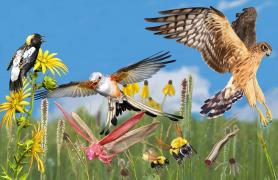Fun things to do and great places to discover nature.
- Help a turtle cross the road. But only if it’s safe to do so. Always carry turtles in the direction they were headed, or they will crawl back to the road.
- Take Mom on a chicken hunt. The beautiful, edible chicken of the woods mushroom starts popping up around Mother’s Day. Look for orange overlapping clusters on stumps, trunks, and logs of dead or dying trees. (Never eat a mushroom unless you’re sure it’s edible.)
- Hooray for National Prairie Day! Celebrate Saturday, June 2. Plant some New England asters, butterfly milkweed, or purple coneflowers in your yard.
- Give the butterflies a puddling station. Put some sand and pebbles in a saucer, add a little water, and set it where the butterflies can find it and you can watch them. summer
- Learn all about fishing at Kids Fishing Days. Each program provides equipment and instruction — all you have to bring is a grown-up! Find your nearest Kids Fishing Day at short.mdc.mo.gov/Zku.
Did You Know?
- Put your ear on a molehill, and you might hear the tiny tunneler’s tummy rumble.
- A mole may eat up to half its weight each day, stuffing its belly with worms, grubs, and other underground creepy crawlies.
- Although its eyes are only good for telling light from dark, its nose knows where to dig to find food.
- Using oversized front paws, moles tunnel quickly — up to a foot per minute — following their sensitive sniffers from nibble to nibble.
What Is It?
- Careful, my bristles can sting.
- I grow up to have spots on my wings.
- When young, I eat leaves on the trees.
- But grown up, I live only to breed.
Careful — those bristles can sting! After spinning its cocoon, this bristly green caterpillar will become a big, colorful io moth. When disturbed, the moth will spread its forewings to show bold eye spots that can scare predators. Females are larger than males and have pinkish brown wings instead of yellow ones. Io caterpillars are leaf eaters, but the moths live only to mate and don’t eat at all. Both caterpillars and moths fall prey to birds and other critters. Learn more at mdc.mo.gov/field-guide.
Critter Corner: Midland Smooth Softshell
This streamlined, water-dwelling turtle has sharp claws on its webbed feet, so be careful if you pick one up. In Missouri, you might spot it on sandbars or mud flats with just the tip of its nose snorkeling above the water. Females eat the larvae of water bugs, but males hang out in shallower water and eat land bugs. In May and June, mama softshells go looking for sandy places to lay their eggs. Learn more at mdc.mo.gov/field-guide.
Also In This Issue


And More...
This Issue's Staff
Les Fortenberry
Karen Hudson
Angie Daly Morfeld
Noppadol Paothong
Marci Porter
Mark Raithel
Laura Scheuler
Matt Seek
David Stonner
Nichole LeClair Terrill
Stephanie Thurber
Cliff White






















